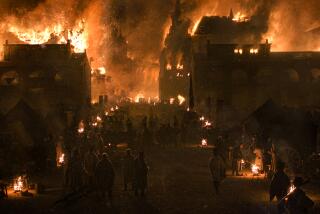Filling in facts when what we crave is legend
- Share via
It’s inevitable that those who write about Napoleon Bonaparte find themselves thinking of their youth and when they discovered the emperor’s existence. Steven Englund remembers reading “The History of Napoleon the First” as a boy attending a Los Angeles junior high school. In his new book on the larger-than-life French leader, he tells us in his concluding chapter -- “Introduction (Misplaced)” -- that it was “the hobgoblin” of his thoughts while writing the book that he was not presenting either Napoleon the soldier or the art of war in a manner that would have met the enthusiastic approval of that young Los Angeles schoolboy. He has, he tells us, written on the political, not the military or intimate, life of his subject.
Yet in “Napoleon: A Political Life,” Englund has written a most distinguished book recounting Bonaparte’s life with clarity and ease, drawn from an enormous body of documents, letters, books and publications detailed in 60 pages of notes. The author’s sly comments accompanying this display of erudition add to one’s enjoyment.
Bonaparte, Englund tells us, lived during a most unusual quarter-century in the “unlikely history of France,” a period that saw not just the overthrow of one of Europe’s greatest monarchies but a revolution that he contends has redefined the very nature of human existence and social order. The Corsican-born Bonaparte supported the French Revolution, he writes, because without it the major aristocrats would have taken all the best posts in the army, leaving lesser posts for minor aristocrats like himself. Bonaparte was won over to the revolution, Englund says, “from the first time that a snot-nosed aristo” at a French school in Autun or the military academy in Brienne snubbed him.
There is a national, and one is tempted to say constant, debate about the man who crowned himself emperor. It is as if there is a mystery about Bonaparte that demands resolution and specialist historians are obliged to participate in the discussion.
Naturally it is of no importance that French television programs suggest that Napoleon escaped from the island of his final exile, St. Helena, and that he did not die there. Others contend that during his first exile on Elba he reformed the whole system of waste collection and disposal. But should one organize the specialists of French history to take part in a debate over whether to celebrate Bonaparte as a revolutionary general or lament him as a tyrant who seized power on Nov. 9, 1799 (known as “18 Brumaire” by the revolutionary French calendar), and established a military dictatorship? Naturally one is eager to know what Englund says about this episode and this debate.
Gen. Bonaparte, who had seized Malta on his campaign to conquer Egypt, returned to France on the frigate Le Muiron in late August 1799. The journey took six weeks (including a five-day stay in Corsica, the last visit he would pay to that island). He landed at the port of Frejus, on what is now the French Riviera, on Oct. 9 and reached Paris a week later. Englund emphasizes that he returned a hero. The workers “sang the triumphs of our armies and the return of our father, our saviour, Bonaparte.” With this heightened popularity, Bonaparte is described as imposing himself on one and all simply by the fact of his returning. We also learn that for the first time since 1793, there was the danger of imminent invasion and of subversion by counterrevolutionary forces. Englund uses the phrase “national mess,” attributing it once to the Marquis de Lafayette.
He also discusses some of the powerful ideas circulating at the time, including those of Francois Noel “Gracchus” Babeuf, who was arrested for leading a plot to overthrow the young Republic’s moderate government, and of Emmanuel Sieyes, Madame de Stael, Benjamin Constant and others who shared an 18th century conviction that society’s problems were amenable to improvement by a better “document,” meaning a better constitution and the creation of a smaller and stronger executive branch of government.
The drama that took place should have been played according to strict rules. A government crisis was to be provoked by the resignation of a majority of the executive body, the Directors. This would allow a majority of the legislature, the Council of Five Hundred, the opportunity to vote the regime out of existence and arrange for a commission to draw up a new constitution. Though Bonaparte, in newspapers he had published earlier in Italy (“France Seen From the Army” and “The Mail of the Army”), which Englund cites in his account of events, had stressed the dangers of royalists winning too much power, it was the left-wing Jacobins who refused to follow their supposed role. The situation was worsened by Bonaparte’s failure to speak effectively either to the smaller Council of Elders or to the Council of Five Hundred. Then, by accident, he was attacked. Englund says that few historians believe a knife was actually used against him; nonetheless, his brother Lucien, president of the Council of Five Hundred, called on soldiers to disperse people he claimed were armed with knives and were being paid by England to attack France’s elected representatives. On the night of 20 Brumaire, a number of legislators agreed to dissolve the old regime and to create a new one, with Bonaparte emerging as one of the new consuls.
But Englund does not see this as the classic watershed of Napoleonic biography. He recalls how Larousse, in his Great Universal Dictionary of 1862, gave two separate entries: There is Bonaparte, who died on 18 Brumaire in the revolutionary year VIII; and there is a separate entry for Napoleon I. Englund also quotes a contemporary French historian who has claimed that the French countryside viewed the events of Brumaire as a coup engineered against the right wing and in favor of the Republic. He concludes the chapter with the words “views change” and writes that he would use the word “farce” rather than Karl Marx’s choice of the word “tragedy” to describe Brumaire. In a later passage, when he recalls Bonaparte’s actions in the transfer of power on Nov. 18 and 19, he says that “the legal formalities” had always been observed.
Englund can also disappoint. We learn that Bonaparte takes refuge on the English Royal Navy ship Bellerophon in July 1815, then we are told that in August he is transferred to HMS Northumberland, which takes him to St. Helena. But what about the days in between, the time in Portsmouth harbor when thousands of Englishmen took to the sea in little boats to see and sometimes to cheer Bonaparte as he stood on deck? And what of the occasion after Bonaparte’s death on May 5, 1821, his body was laid out and the public allowed to view it, when one English soldier, leading his small son by the hand, tells him to take a good look, that “he is the greatest man in the world.” Englund doesn’t tell us this story; we know it already. So although Englund’s magnificent book tells us much that we did not know and gives us a great deal to think about, we want to know more -- because it’s Napoleon Bonaparte. *
More to Read
Sign up for our Book Club newsletter
Get the latest news, events and more from the Los Angeles Times Book Club, and help us get L.A. reading and talking.
You may occasionally receive promotional content from the Los Angeles Times.






